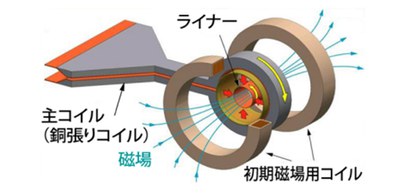
Electron-hole symmetry breaking of Dirac electrons in graphene
Ultrahigh-magnetic field cyclotron resonance experiments reveal properties of Dirac electrons
A group of researchers from The University of Tokyo, Kwansei Gakuin University, and Osaka University conducted ultra-high magnetic field cyclotron resonance experiments using the epitaxial graphene, the carbon layer formed on top of this interfacial layer, examining Landau level (LLs) in graphene.
They demonstrated that cyclotron resonance (CR) splitting caused by the electron-hole asymmetry, e.g. electron-hole symmetry breaking of Dirac relativistic electrons, took place in graphene.
Since monolayer epitaxial graphene has more excellent electric and thermal conductivity than conventional semiconductors and can be applied in various electronic devices, scientists are conducting research and development of graphene applications.
Due to the massless nature of these Dirac electrons in graphene, graphene has very high electron mobility and electrical conductivity. Thus, knowing the properties of Dirac electrons is essential for enhancing properties of graphene used for electronic devices.
Since the electron-hole asymmetry of the energy band was recognized as quite small and difficult to be observed in monolayer graphene, such electron-hole asymmetry observed in CR spectra of a normal monolayer graphene remains unreported except for the case of a strained graphene.
The electrons undergo a circular motion in the plane perpendicular to the magnetic field. In terms of quantum mechanics, the energy of the electrons is quantized and each quantized energy level is called the Landau level (LL). Since the value of Fermi velocity (the electrical conductivity is determined by mobilities of the electrons and holes) can be deduced from the LL spectroscopy, the LLs are used for evaluating physical properties of devices.
LLs develop linearly with the magnetic field B (magnetic flux density). A high-magnetic field environment offers high-energy resolution to the CR spectra. It is possible to observe splitting of LLs with high-resolution magnetotunneling spectroscopy in a high magnetic field. An ultra-high magnetic field (as high as B∼400–500 T) could potentially manifest the CR splitting caused by the electron-hole asymmetry.
In this study, the researchers put a 2-mm cut graphene sample on the electromagnetic flux compression 1000-T-class megagauss generator using near infrared lasers as a light source, performing high-resolution CR spectroscopic measurements.
The researchers observed a visible splitting of the spectra as a consequence of the increased peak splitting separation in the cyclotron resonance spectrum in 300–500 T of the magnetic field. This demonstrated that there was a slight gap in the CR between a hole and an electron LL, e.g. breaking of the electron-hole symmetry in the Dirac energy dispersion.
This group demonstrated that electron-hole symmetry breaking of Dirac relativistic electrons in graphene was one of the physical properties reflecting the massless Dirac dispersion of electrons near the Fermi level. This group’s achievements will lead to the development of basic research and applied research on quantum electronics using monolayer graphene.

Figure 1

Figure 2

Figure 3
The article, “Quantum limit cyclotron resonance in monolayer epitaxial graphene in magnetic fields up to 560 T: The relativistic electron and hole asymmetry” was published in Physical Review B at DOI: https://journals.aps.org/prb/abstract/10.1103/PhysRevB.101.115420
Related Links
